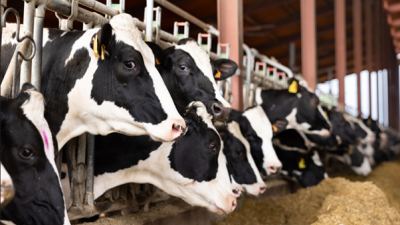Mitigating heat stress in transition cows

Heat stress on a dairy farm has far-reaching effects, impacting more than just the animals that are impeded by the rising temperatures. Negatively impacting dairy herd performance, where dairy farmers really feel heat stress hitting is on your production profitability. Underperforming cows produce less milk, which means less money.
To effectively tackle heat stress on your dairy farm, you must first assess your current situation. You can easily do this with our Heat Stress Strategy Evaluation.
There are numerous areas of every dairy farm where the effects of heat stress can be easily identified and, with the right management, effectively addressed. This blog is one part of a series that looks at these heat stress risk areas:
1. Feed and Forages
2. Calves
3. Heifers
4. Milking cows
5. Transition cows
In many regards, the impact that heat stress has on a dairy farm is an immediate production issue, affecting milk production. But, when we look at transition cows, there are also drastic implications for the farm’s future. A heat-stressed pregnant cow will be impaired when trying to provide the nutrition that their unborn calf needs, causing problems farther down the road.
So, what is the best approach for transition cow management? What should you be looking out for when monitoring heat stress, and how can you best tackle the situation?
Signs of heat stress
When your transition cows are suffering from the heat, they will begin to act abnormally. Some tell-tale actions to keep an eye out for include:
-
Decreased dry matter intake.
-
Increased breathing rate and panting. This will lead to essential mineral losses.
-
Reduced activity but less time spent lying down.
-
Increased water intake.
Some of these actions can lead to an increased rate of feed passage, so also be on the lookout for:
-
Inconsistent manure.
-
Acidosis.
-
Increased lameness.
-
Lower milk solids.
Other than these more obvious signs that your animals are stressed, there are numerous internal issues that could also be occurring due to the higher body temperatures. These manifest as:
-
Increased metabolic disease risk, such as respiratory alkalosis and metabolic acidosis.
-
Altered placental function.
-
Decreased mammary tissue growth rate.
-
Lower circulating immunoglobulin level.
As mentioned above, these issues ultimately lead to the unborn calf not getting the nutrition it needs. As such, transition cows suffering from heat stress can give birth to calves with a 4.5 kg lower birth weight.
Housing and management
A big part of managing heat stress in your transition cows is providing them with a comfortable resting area where they can escape the heat. Space is the operative word here, as your animals should have ample room at all points of the day and night. To ensure this:
-
Keep stocking density in close-up pens below 80%.
-
Provide at least 12–14 m2 per cow in the straw yard.
-
Feed troughs should provide 75 centimetres per cow.
-
Allow for free choice access to clean water with space for 10–15 centimetres per cow.
Ventilation is also crucial in this situation. Where possible, open up the housing to allow for airflow and natural ventilation. Fans installed throughout the barn can also be very effective. These measures help to decrease humidity, which results in drier bedding and, subsequently, lower risks of mastitis and digital dermatitis.
It is also advisable to install showers and drying fans in areas where animals congregate regularly, such as holding pens. By soaking and drying the cows in cycles, you can simulate the cooling effects of sweat.
Feeding and nutrition
When it comes to feeding, one simple but effective adjustment is to feed at cooler parts of the day, mainly evening and night. The right diet formulation is also essential to optimising your transition cow’s performance during heat stress. It is advisable that you:
-
Maximise rumen function by using a good basal ration and live yeast.
-
Select higher quality forages.
-
Partially replace forage with high-fermentable fibre by-products, such as beet pulp and soy hulls.
-
Use more digestible feed ingredients. These have lower heat production during digestion.
-
Guarantee fresh, palatable, high-quality feed is always available.
-
Ensure uniformity of mixed and delivered rations, minimising feed sorting and reducing SARA risk.
-
Choose the right source of carbohydrates. This could be corn grain and fermentable starch or glucose-formed products, such as MPG, glycerin and maltodextrins.
-
Aim for sugar at 6–7% dry matter.
-
Consider adding dietary fat, such as a fractioned milk fat precursor, preformed fatty acids (C16:0) or omega 3 and 6 fatty acids.
-
Supply enough ammonia to satisfy their requirements for rumen bacteria.
-
Maintain rumen NH3 levels throughout the day to ensure optimal supply to the rumen microbes.
There are a number of Alltech products that can also help you make the most of your feed during times of heat stress. Using Yea-Sacc® will help stabilise the rumen environment and optimise function, Bioplex® can offer better mineral availability and Sel-Plex® aids in immunity support.
To help you easily keep track of all of this advice, we have summarised the key points in a useful, one-page document that you can download. Read and download it here.
While effectively managing heat stress in your transition cows is vital for the current and future performance of your dairy farm, there are many other areas where it can challenge your productivity. To learn just how robust your management strategy is, and to gather advice on easily implemented improvements, fill out our Heat Stress Strategy Evaluation here.














